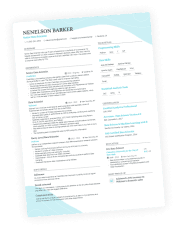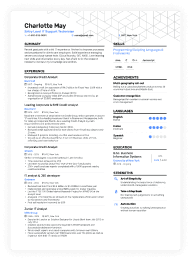Creating a professional development plan is about far more than just checking off a list of goals. Sure, it’s a good way to move your career forward, but it’s also about bringing you purpose and peace of mind. Today, with a year and a half of hindsight, I’m bringing you my story and all of the hard-won lessons that came with it.
Unemployed for the first time in 10 years…
Upload & Check Your Resume
Drop your resume here or choose a file. PDF & DOCX only. Max 2MB file size.
I woke up and immediately felt a profound sense of confusion. It was the first day that I was unemployed. It felt weird even thinking about that word in relation to myself.
I started working full-time when I was in my first year of university and had spent precisely 10 years with no employment gap. This was the first time when I didn’t have anything lined up after quitting my previous position.
I felt like I had no direction. Which was strange, but at the same time amazing. It gave me so much freedom! I was looking forward to shopping around, checking what the job market has to offer, and figuring out my priorities.
Today, I want to share some of the things I did – and some of the things I should’ve done – when planning my next career move. I hope this guide helps you, no matter if you’re looking for the right next step, a big career change or something that finally makes you happy.
Stage 1: Find your professional development and personal development directions
When I was planning my last career change, I already knew marketing was my field. But even in this case, I had the option to choose from many different directions. Did I still want to go in a company marketing team? How about an agency? What about freelance?
Just as the famous jam experiment suggests, when presented with too many options choosing becomes that much harder.
I needed a system.
And any good system for professional development planning should look at your personal development, as well. So the next exercises look at life and all its domains holistically.
Direction planning by looking back
Human beings are bad predictors of the future. But then again, we’re good at remembering our past and this is also a great starting point. So you can start by looking at your past experiences and your current situation to get some patterns out.
Health/Work/Play/Love Dashboard
An idea stolen from a book is the dashboard presented in Designing Your Life. It’s a cleaner version of the life domains and it shows clearly what’s lacking in your life. Here’s my example. You can find the template on the book’s website.

It’s a very quick exercise if you do it the way it’s intended – but if you put things into perspective, extend the period of looking forward from 2 weeks to 2 months or half a year, you’d get a different challenge completely.
Workview and lifeview
If you need to dive deeper than creating the dashboard, you might venture into creating a full Workview and Lifeview. This is a more detailed account of how different areas of your life play together and what’s their significance. Some questions you might want to answer:
Workview:
- Why work?
- What’s work for?
- What does work mean?
- How does it relate to the individual, others, society?
- What defined good or worthwhile work?
- What does money have to do with it?
- What do experience, growth, and fulfillment have to do with it?
Lifeview:
- Why are we here?
- What is the meaning or purpose of life?
- What is the relationship between the individual and others?
- Where do family, country, and the rest of the world fit in?
- What is good, and what is evil?
- Is there a higher power, God, or something transcendent and if so, what impact does this have on your life?
- What is the role of joy, sorrow, justice, injustice, love, peace, and strife in life?
Don’t overcomplicate things – each of these two exercises should take about 30 minutes and result in a text of 250 words or less. Looking at the two, it should be easier to identify where the two views complement each other, where they clash and if/how one of them drives the other.
Write a good time journal
Another way of understanding what’s important is looking back. What are the activities you’ve done over the last day or the last week? Write them down and rank them based on three criteria:
- Engagement: how interesting was the activity? How present you felt while doing it?
- Energy: did it energize you or did it leave you in need of a break?
- Flow: did you achieve that state of flow, where you don’t feel time passing, as you’re completely immersed in the activity?
Here’s an example. Although I feel engaged when drafting marketing copy, it’s a very draining activity for me and halfway through I feel like I need to rest and recharge. But when analyzing ad campaign performance, I can go on for hours and forget about lunch (or, ahem, bathroom breaks).

If you look back at a couple of weeks’ worth of activities, you’ll get a clear sense of what works for you and what doesn’t.
Direction planning by looking forward
By now, you’ve probably gotten a good idea about where you stand, so now it’s time to look at where you want to go. I first saw these exercises in Jenny Blake’s book Pivot, which was an important part of my professional development journey.
Your ideal day
Turns out extracting what you want in life is easier when going into specifics. Think about your ideal day. Say it’s 3 years from now:
- What do you think of first thing in the morning?
- What’s the purpose you get out of bed?
- How is your day structured?
- How does your workspace look? What do you do there?
- How much time do you spend with your close ones?
- What gives you a sense of accomplishment at the end of the day?
- What energizes you and what drains your energy?
You may want to go and answer each question or you might want to craft a full story – here’s Jenny Blake’s Ideal Day Mad Lib template, just copy and fill in!
Values mind mapping
Now give that story a thorough read through and extract any common topics you see. Are you focused on family or is travel crazy important for you?
You can easily create a mind map of your values – it’s a clean and visual way of setting your priorities. I am not a big fan of mind maps, however, this is a rare situation where I find them useful. Here’s an example of my mind map:

Planning by life domains
Some people find mind mapping difficult, as they simply don’t know where to start. It’s true – the process is messy and lacks structure. If you feel like going in with some help, you can plan through what Michael Hyatt calls the 10 Life Domains. The full list includes:
- Intellectual
- Emotional
- Physical
- Spiritual
- Marital
- Parental
- Social
- Financial
- Vocational (career-related and professional)
- Avocational (hobbies and interests)
I personally find these overwhelming and I have combined a few together – e.g. Emotional and Spiritual, Intellectual and Vocational. But it’s a nice comprehensive list that will point you towards all key areas of your life. So I’d include as many categories as I need, but not more!
Stage 2: Inventory checking – professional skills and personal strengths
By now you’ve taken the map, you spread it out and marked point A, your current position and point B, your desired state. But how do you get there? Do you have a car, a boat, or a helicopter? Time to check your inventory.
Mapping your strengths
After having a clear picture in my head of what I wanted, I checked that against my strengths. This is important for 3 key reasons:
- Reality check: My dream future might be that of an astronaut, but at 30 and with no STEM background it will remain a dream. Aiming high is good. Aiming too high is simply a waste of time.
- Development planning: Say you’re 30% on the road to your ideal future. Knowing this gives you a sense of progress and a way to plan what you need to do to get to 60%, 80%, 90%.
- Work satisfaction: Turns out when you get to use your key strengths at work, you feel more accomplished and engaged. So knowing what your strengths are and sculpting your work around them has long-term benefits.
There are many surveys that can help you get to know yourself better. A popular one is the Myers Briggs test, but I find it highly dependant on my mood and the time of taking it.
I’ve done StrengthFinder 2.0 2 times already. The information in it is much more stable and useful, especially when talking about work-related strengths.
For a free alternative, you can check the VIA character strengths (based on Dr. Martin Seligman’s work). It is geared towards personal as well as professional strengths.
Once you find out your strengths, take a close look at the forward-looking exercises you’ve done. Do you get to use all your strengths in your ideal future? Do any tweaks and start planning how to get where you want to be.
Listing your assets."
No development journey happens in a bubble. There probably are people you can rely on, connections you can leverage, learning opportunities to take. You can map those out by using Jenny Blake’s Opportunity Grid, which has three categories:
- Who are the people you can learn from or get inspired by?
- What are the skills you want to develop and the ones that will be most useful?
- What are the projects you can pursue in your development?
Personal SWOT analysis
After so much thinking and checking, you’d have an overwhelming amount of information, so it’s time to summarize in the shape of a personal SWOT analysis. The concept is the same as the popular corporate/brand SWOT – listing strengths, weaknesses, opportunities, and threats you need to be aware of. Here’s how those apply to personal development.
- Strengths:
- What am I good at? What areas do I pick up easily?
- Any qualifications I can make use of?
- What are my morals and values?
- Weaknesses:
- What do I still need to learn?
- What work areas drain my energy?
- What do I have to get better at?
- Opportunities:
- What projects can I pick up?
- What contacts can I use?
- What new skills in my industry can I learn?
- Threats:
- Are there key skills others in my industry have that I don’t?
- What parts of my job am I not really proud of?
- How does technology affect my job?
Having all of this information codified gives you a good starting point for actually making a plan.
Stage 3: Roadmap development
So here we are, the meat of it. When I was doing my development plan, I didn’t spend nearly enough time on the first two stages, so I wanted to give you a bunch of options here.
Going forward, it’s time to look at different roads to take.
Puzzle building
This is the actual approach I took when reviewing new opportunities. I had my current state, my point A, and my idea of a great future, point B. I didn’t plan the whole process going to point B but treated my next step as a piece of a puzzle between the two. The criteria then got really simple:
- Does that opportunity fit my strengths and does it build on what I’m good at? So does the puzzle piece connect nicely with point A?
- Does it get me closer to my desired future? Does the puzzle piece go closer to the point B state or does it veer off in another direction?
I had never considered so many options: startups, big companies, digital agencies, freelance work, part-time… But I didn’t feel overwhelmed anymore, as I could easily single out the viable opportunities from the noise.
Alternative odyssey plan
A much more structured approach that you can take is looking at the big picture even before going into opportunities evaluation. I found this interesting approach in Designing Your Life and would’ve really liked to test it out.
The exercise goes, as follows:
- Look at your Good Time Journal and pick one energizing, one engaging and one flow activity.
- Build a mind map for each creating branches of related activities in at least 3 degrees out.
- Look at the outer ring, pick 3 things and create a job description based on them.
- Then build a 5-year (or 3-year) plan of how this “job” might develop.
- Rank it based on the resources needed, your liking of the plan, your confidence in succeeding, the plan’s coherence. Jot down the key questions that the plan depends on.
Here’s a look at an Odyssey plan example. I created it for a fictional situation where I’d like to invest time in empowering women through branding. It’s super basic, but it’s just an illustration of what you can work on. Again, the template can be found on the book’s website.

Getting ideas through coffee
Of course, those alternative plans are an equivalent to looking at a crystal ball – it’d be great if it works, but it really doesn’t.
To get back to reality, you might want to check with someone “living the dream”. Access to people currently in your dream job can be surprisingly easy with the availability of professional networks and online calls. So do your research, buy that person a coffee (real or virtual) and talk to them about their career and their day to day work. What you’d want to get from these conversations is answers to two questions:
- Is this really what you’re looking for? Does the reality match your dreams?
- If yes, what is the way to get there?
It might feel awkward at first, but people like helping others and they certainly love talking about themselves. So you will get them sharing in no time.
A great example of that strategy can be found on Fifty Coffees. A New Yorker set on a project to find her next adventure… by talking to people! She did just 14, though, before getting a job for Esther Perel, a famous relationship expert. Still, the interviews are quite interesting. They illustrate well what doors can open to you over coffee.
Stage 4: Start testing
By this point, you’d probably have a clearer idea of what the right next step is. Hopefully, you wouldn’t have had those coffees all at ones, as you’d be too jittery and that will stop you from the next important step – giving those cool ideas a go.
In Pivot Jenny Blake calls this stage “Pilot”, and the authors of Designing Your Lifetalk about “prototyping”. In any case, think of it as a low effort way to dip your toe into the water. There are three benefits here:
- It helps you get a clearer picture of what working in this new field full time would look like;
- It gives you some initial experience, new contacts, and maybe even a reputation that you can then use to your advantage;
- It lowers the risk for you in financial and any other way.
This stage can take a lot of different shapes, but the important thing is that it doesn’t take you more than 10-20% of your time and effort so that you can do it parallel to a current job you have.
Some ideas in that direction would be volunteer work, doing part-time projects for friends, even doing an internship with a company. Test, test, and test again. Once you find something that sticks, you’d be at the perfect position of jumping on that opportunity.
If you are actually planning to go into marketing, here’s a dedicated post on planning a marketing career.
How my career planning went
I first opened up Pivot on a three-hour flight headed to Madrid for a much needed long weekend with my partner. It was tough to not know what I’ll be doing once back, but I was determined to use the upcoming months well to understand what I really want.
My professional development journey started on that plane to Madrid and ended a month and a half later. It took long hours of priority building, 20+ meetings with friends and work acquaintances, five or more actual job offers.
I didn’t go with the highest bidder for my marketing skills. I went with something more important. For the first time, I was choosing a company based on the team and the personal skills of the founders. And it’s something that I didn’t really know I was looking for before doing some personal development planning.
A year and a half later, I’m the happiest I’ve ever been at a company. I love Enhancv and I’m still confident this was the right choice.
Hope you find the right choice, as well. Let me know how I can help along the way!
Make one that's truly you.



